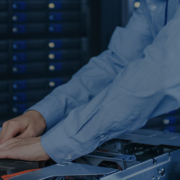Buying a new work computer can be a daunting task. With so many brands, features, options, and price points out there, it’s hard to say what a good deal actually is and whether or not you’re getting what you need out of a new computer.
To help you out, let’s take a few minutes to go over the important factors you need to consider before investing in a new computer.
 Operating system
Operating system
The first point of concern should be the operating system. Once you figure out what OS you need, it can narrow down your choices significantly.
Whether you plan to use Microsoft Windows, Apple Mac OS, or even Linux, just make sure you’ve settled on your choice before going shopping.
- Windows is typically the default choice for most business computers — except in the fields of design and graphics, in which case Macs reign supreme.
- Macs are growing in popularity among users who may be familiar with the Apple interface on their iPhones and iPads. Since Mac OS only works on Apple hardware, however, you’ll be paying a premium to use it.
- Linux is a frequent choice for software development and IT, since it’s more stable and secure than Windows.
 Type
Type
After the operating system, the device type — desktop, laptop, or maybe even tablet — should be the next point of order:
- Desktops offer more computing power for the price and are easy to repair and upgrade, but they’re not at all portable. They’re best for people who will be doing most of their work at a desk.
- Laptops are more expensive for what you get and typically can’t be as powerful as high-end desktops, but they’re smaller and also portable.
- Tablets are the most lightweight of the three options. They usually have less computing power and storage than a laptop, but they’re highly portable with a good battery life. (Note that not all of the apps you use may be available on a tablet.)
 Price
Price
While it’s hard to deny the appeal of bargain hunting, a new work computer is one place where you definitely shouldn’t cut corners. You should only buy from large, established vendors that have a decent reputation.
It can be tempting to save a little money right now by going for the cheaper option, but ask yourself whether you’ll really be cutting costs by doing so. Less expensive computers are typically less powerful and have less storage, which can make them slow down faster than high-end options.
All this means that if you buy a cheaper computer, you might be back on the market sooner than you think. By being flexible in terms of budget, you’re more likely to be satisfied with your purchase now and into the future.
 CPU
CPU
The central processing unit (CPU) is the powerful chip that’s the digital “heart” of your computer, performing the vital calculations that make everything happen.
CPU speed is measured in gigahertz (GHz), and higher numbers generally correspond to a faster computer. Modern computers typically have “dual-core” or “quad-core” CPUs, which means that they have the power of two or four CPUs within a single unit.
To meet the requirements of daily activities at your business, most computers should have a CPU that’s at least dual-core and that has at least 2.5 GHz. Computationally intensive tasks such as rendering 3D models or crunching large amounts of data will likely need a CPU with eight or more cores.
 RAM
RAM
If the CPU is your computer’s heart, then the random access memory (RAM) is the brain. RAM is where your computer stores data that it uses when executing different calculations and processes.
It’s almost always better to have more memory than less, especially when you’re running programs that take up a lot of system resources. 2 gigabytes of RAM is typically the minimum that business computers need.
The good news is that if you have a desktop, you can easily upgrade the amount of RAM. Since laptops are designed to be compact with little wasted space, adding more RAM (or doing other upgrades, for that matter) typically isn’t possible.
 Storage
Storage
Data resides on your computer’s hard drive, and the space it takes up is measured in gigabytes (GB).
Although 250 GB should be enough space for most business purposes, this can vary by employee function. If you’re working with a lot of multimedia files or massive amounts of data, then you’ll want to have as much space as possible, perhaps up to 1 terabyte (1000 gigabytes).
Just like you can install more RAM, you can also augment the storage available to you with an external hard drive.
Final Thoughts
Whichever computer you end up buying, remember that it should last at least two or three years and meet your current business needs. Spending a little more money during your purchase can save you a great deal of time and money in the long run.







